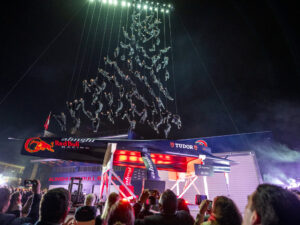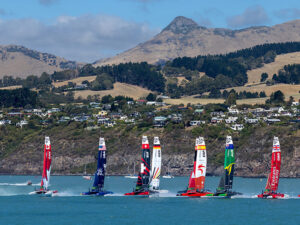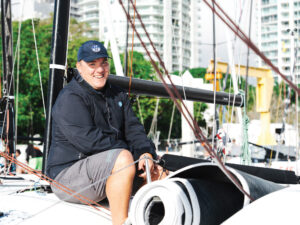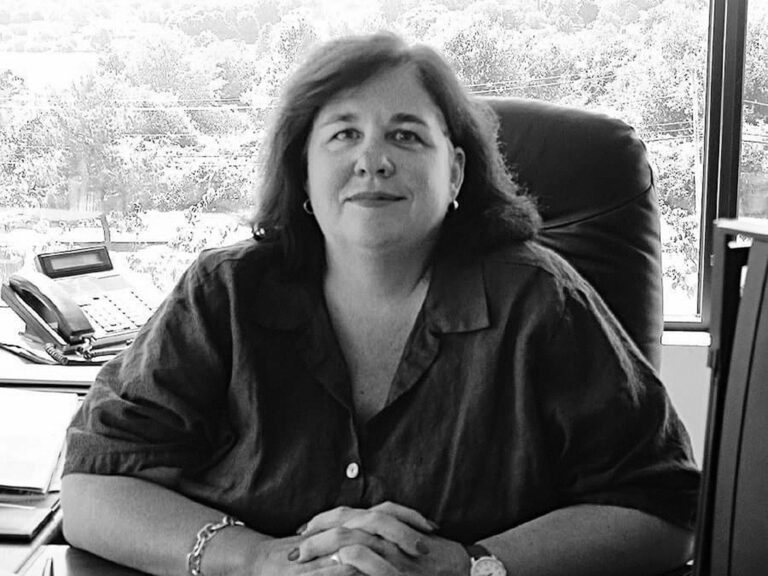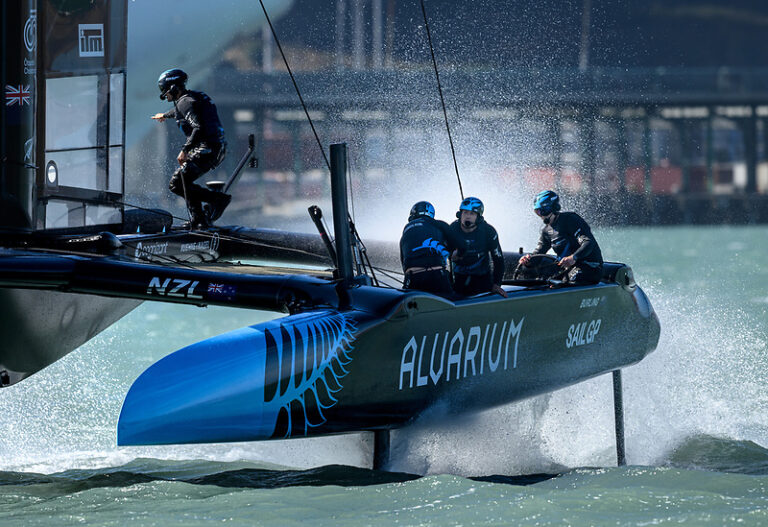At the age of 34, Mike “Moose” Sanderson may well be the world’s best all-around sailor. Stop and think about that one for a moment. Moose who? Best what? This is neither hype nor hyperbole. In fact, since breaking into the grand-prix scene in 1993 as a 21-year-old driver, trimmer, and sailmaker aboard the Whitbread Maxi New Zealand Endeavour, no one has accomplished more-across so many disciplines, at the sport’s highest levels-than the affable, ultra-competitive Sanderson.You want to discuss a sailing career? As they say on SportsCenter, let’s go to the highlights.We’ll skip, for now, the national titles he won in skiffs and sportboats back home in New Zealand, and commence with round-the-world racing; as crew, he won in his first outing, in 1993-’94, then came back four years later aboard Merit Cup. At press time in May, in his first command as a Volvo skipper, he’d led his ABN AMRO One team to an insurmountable lead in the current edition of offshore sailing’s grandest race.Then there’s the America’s Cup. Sanderson’s been in the thick of it many times: aboard Tag Heuer in 1995, as the mainsheet hand for Team New Zealand’s invaluable back-up boat in its winning 2000defense, and as the starting mainsheet trimmer for the 2003 Oracle BMW Racing campaign.Back to the distance stuff: Sanderson was a key player onboard Mari-Cha III when it lowered the transatlantic monohull speed record in 1998. He played a much more prominent role in the development of the 140-foot schooner Mari-Cha IV, and was the boat’s racing skipper in its string of record-setting performances, including another successful transatlantic assault in 2003, a dominating win in the 2004 Pacific Cup, and a victorious effort in the Rolex Transatlantic Challenge in 2005.And just for the heck of it, in his first swing at singlehanded ocean racing, he finished third in the brutal 2004 Transat solo race across the Atlantic. If the daggerboard of his Open 60, Pindar AlphaGraphics, hadn’t broken, he probably would’ve won it.Along the way, he’s crewed aboard winning boats in the Cape Town-Rio Race, the Sydney Hobart, Kenwood Cup, and Admiral’s Cup. In match racing, he’s won the Congressional Cup, the Bermuda Gold Cup, and the 2002 Swedish Match Tour.All of this in 13 short years of sailing. Sanderson has a brief take on it all, which speaks volumes of his character. “I guess you could say I’ve had a good little run,” he admits. Yes, he’s humble, too. Which begs the obvious question: Who the hell is this guy?Mike Sanderson was born and raised in the smallish New Zealand town of Whangarei, on the North Island. His father was an orthopedic surgeon, his mother a nurse. His two sisters also went into health care, but it was a career path that never much interested the family’s lone son, who dropped out of private school to become a sailmaker with North Sails.”My parents will tell people I was very young-about 6-when I began trying to work out how I could make a living racing yachts,” he says.He grew up in a sailing family, though not a rabid one-his father’s work was too demanding. But the five Sandersons thought nothing of taking off on a two-week cruise aboard their 25-footer, which they also raced at the club level. Whangarei wasn’t Auckland, but there were plenty of good, young sailors around, including future America’s Cup stalwarts Robbie Naismith and Matthew Mason. “They were already legends,” he says. By the age of five, Sanderson was sailing an Optimist, but he didn’t take the traditional Kiwi step to the P-Class. Instead, he went directly to two-man skiffs.”Those were my early days of enjoying the development side of the sport, where you’re working on what’s making the boat tick, and how to sail it faster,” he says. “It started me down that road.”By his late teens, Sanderson had joined North and had also moved into a new sportboat class, the Elliott 5.9. After winning the 1991 Nationals, he attracted the attention of Whitbread veteran Murray Ross, who’d just raced around the world with Grant Dalton and was recruiting crewmen for Dalton’s next campaign aboard New Zealand Endeavour. Over beers, Ross asked Sanderson if he might be interested. For a young Kiwi who’d been raised on the tales of Whitbread glory, this was an unreal offer. In fact, Sanderson didn’t believe it. “I took it as bar talk,” he says. Two weeks later, Ross called: Why hadn’t he contacted Dalton? “So I did,” says Sanderson. “And I got aboard.””I remember it quite clearly,” says Dalton. “There were 14 on the boat and I’d probably selected 10 or 11 already. So there were 3 gaps. I remember that day, I’d done about six interviews and had six more to go, and Moose walked in. He stood out. A lot. He was the youngest but you could tell he was well educated, spoke well, was confident, and knew what he wanted. Even at that age. He would’ve been easy to reject, just by his C.V., because he was so young. You could just tell, there was something there.”Talk about an offshore apprenticeship. Many of Endeavour’s crew were grizzled veterans of Peter Blake’s Lion New Zealand and Steinlager 2 campaigns. Several had acquitted themselves well in New Zealand’s first foray in the America’s Cup, too, aboard the “plastic fantastic” KZ-7 in Fremantle, Australia. (The ability to excel inshore and offshore would become a trait of Sanderson’s, as well.) “We had the likes of Dalts, Kevin Shoebridge, Glenn Sowry, Mike Quilter, a full Kiwi line-up of the very best,” says Sanderson.”It was amazing. We did everything in that race that I’d been reading about in Whitbread books. We had extreme doldrums on the way down, the likes of which I haven’t seen since. We got so far south the wind gear froze in the Southern Ocean and ice was hanging off the lifelines. Six months earlier I’d been launching my Elliott 5.9, and now I was steering a $5-million sponsored boat, with the hopes of a nation behind us, and all the top guys, who used to be my heroes, trimming the chute.” To top it all off, Endeavour won its maxi class.Next up was Tag Heuer, with skipper Chris Dickson, in the 1995 America’s Cup off San Diego. While the racing was intense and interesting, Sanderson also received a close-up view of what it’s like to wage a campaign with limited resources, another valuable lesson. More were learned in his next event, a winning effort in a race around New Zealand’s North Island, which he sailed with his good mate, Brad Jackson, in a 50-foot, Greg Elliott-designed, wing-masted schooner. That experience would prove invaluable on a future project called Mari-Cha IV.In 1997, Sanderson reunited with Dalton for the next Whitbread, this time in the two-boat Merit Cup Volvo 60 campaign. They ultimately finished second, behind Paul Cayard’s EF Language. It would be a few more years before Sanderson sailed another round-the-world race, and then he’d be running his own show. And when Sanderson hears people compare it to a Dalton program, he takes it as a high compliment.Several important things happened before Sanderson took command of the two-boat ABN AMRO campaign. In hindsight, they played substantial roles in his recent Volvo success. First, he became highly involved in the Mari-Cha III and IV campaigns. His involvement, at first, was pure serendipity: Someone called the North loft in Auckland to inquire about sails for a 45-foot ketch. Because Sanderson had experience with the ketch-rigged New Zealand Endeavour, he drew the straw. Turns out, it was a 45-meter ketch. Welcome to the world of Mari-Cha. Sanderson arranged to help with wind-tunnel testing and sail development on M-C III, and was elevated to the design team for M-C IV. He brought Greg Elliott onboard and, together, they helped advance the concept of a towering split rig. Then he put his ideas into practice, with multiple crossings of the Atlantic and Pacific. It was an invaluable exercise in converting theory into reality.Next, he trimmed main for Oracle BMW Racing for two years: “You’re very much the throttle man, plus part of the performance team working on the design of the new boat while trying to speed up the old boats.” With each step, Sanderson-who was already a wonderful seat-of-the-pants sailor-was adding new tricks to his development repertoire. Finally, having recently begun dating British solo-sailing star Emma Richards, who’d finished fourth in the 2002-’03 Around Alone race, he delved into the world of Open 60s. For a while, the pair sought sponsorship for their own Volvo entry. Sanderson saw the Open 60 as a logical training platform. “Once the Volvo 70s were announced I sort of realized that the Open 60 was the closest thing out there at the moment to a Volvo 70,” he says. Sanderson and Richards acquired a well-used Open 60 and put it back together. By the time the 2004 Transat rolled around, Richards had announced her retirement from solo racing. “We had the boat,” says Sanderson. “It would’ve been crazy if I hadn’t given it a shot.” So he did, thriving in his first solo ocean race, and earning a third-place finish in a demolition derby where two Open 60s were dismasted and a third lost its keel. “I found it very satisfying,” he says. “The mere fact that you had to deal with every problem yourself was good.”He also came away with important knowledge he would use in the very near future. Sanderson once believed that solo racers weren’t playing with a full deck, but now he understood that there were skilled racers in its ranks, and that Open 60 features, such as twin-rudders, spinnaker snuffers, and hank-on sails, might be very useful on a Volvo 70-very useful, indeed.When Roy Heiner walked down the docks in Plymouth, England, just before Sanderson’s Transat effort, he was a man on a mission. He was heading up a Volvo program for the Dutch bank ABN AMRO, and he needed a skipper. The forces in his universe were about to become aligned. Sanderson and Heiner knew one another from the BMW Oracle campaign, where Heiner served as a coach, and skipper of the No. 2 boat. Before shoving off on the Transat, Sanderson was waiting to hear from one more potential Volvo sponsor. By the time he reached the finish line in Boston, he knew that road was a dead-end.Days later, he and Heiner were face-to-face with the ABN’s managing director in Amsterdam, and a few days after that, Sanderson had a new job.Heiner, too, was a Volvo veteran, most recently as skipper of Assa Abloy in the 2001-02 race, when he was fired after the first leg. In accepting the ABN role, Sanderson saw Heiner’s experience as a huge benefit.”It’s terrible to say, but one of the best things for me is that Roy had a tough time,” he says. “Because right from the start, he vowed and declared that this campaign would not be run from ashore, that it would be sailor-driven. The sailors would be led by the skipper and that’d be the end of it.”That said, Sanderson inherited decisions that had been made, for timing’s sake, before he’d signed on. The first regarded the design team, led by Juan Kouyoumdjian, a young yacht designer considered by many to be a bit of a maverick. “I’ll be honest, I had to commit before I was comfortable with that,” he says. “I’d just worked for three years with [Bruce] Farr [on Oracle], my previous two [Whitbread] laps had been with Farr, and every race since the 1970s had been won on Farr boats. But as soon as I got there and saw the path the design team was going down, and after I spent some time with Juan, I was instantly comfortable.” His first priority was to assemble the crew he’d take into battle. “The key thing is to get the best people around you that your budget can buy,” he said. His first call was to Brad Jackson, with whom he’d circled the globe twice, and who was also slated to serve as the best man at his wedding to Emma Richards, at the May stopover in Portsmouth, England, following Leg 7. “He was a no-brainer,” says Sanderson. “So the day after I got the job there were two of us. And we worked on getting a third, then we all set our sights on the fourth, and so on.”Once the team was assembled, they could concentrate on making sure he got the right boat for the job. Though Sanderson had a bit of input on the first ABN boat-ABN AMRO Two, known in-house as the “white boat” and campaigned by a select team of twenty-somethings-he said it was really “Juan’s best shot at it with the time he was given.”The second, a black boat affectionately called “Black Betty,” was a different animal altogether. “When we had all the people in place we could start working with Juan on what was going to be our baby,” says Sanderson. “We were with that boat from Day One.” And what a boat it’s proven to be, a powerful reaching machine perfectly matched to the conditions they’ve encountered around the world. It’s not at all a stretch to say Sanderson had spent his entire young life preparing for this opportunity, and that everything he learned from the skiffs to Mari-Cha IV, was manifested in ABN AMRO One. When his moment came, he seized it.Did Sanderson know from the outset, that he and his team had hit a home run?”He said in the beginning that it was such a different boat than the others that they’d either be at the top of the board or the bottom of the board,” says Richards.Now, of course, we know how that turned out.So, who then, exactly, is Moose Sanderson?ABN navigator Stan Honey, who’s literally been at Sanderson’s side throughout the Volvo race, probably has a better take than most: “He’s a superb seaman, a fabulous sailor and sailmaker. He really knows how to tune and configure boats. But he’s soft-spoken, and tends to sail with similar sorts of guys, which makes it a real pleasant and professional experience to sail with him. He doesn’t have a degree in hydrodynamics or naval architecture but he’s worked with guys who do and he knows all the principles. He’s got the sort of confidence that if people can’t explain it to him it probably doesn’t make sense.”One asks Sanderson a similar question-why aren’t you better known? Not surprisingly, he deftly steps around it. “I guess I just haven’t been on the front line, in the limelight, as much as others so people are often quite surprised to know I’ve done as much sailing as I have,” he says.So let’s recap. Moose Sanderson is at the top of his game, doing exactly what he loves to do. Following the Volvo, he’ll return to the Open 60 game with a brand new boat, and with who knows how many offers to come. He’s young, fit, and married to a beautiful woman who also happens to be a world-class sailor. So maybe we should just give Richards a chance to chime in. Is Sanderson the luckiest guy in the world, or what?”Well, if you just say that, it assumes he’s just been lucky,” she says. “You’d just need to mention in there that the harder you work, the luckier you get.”


